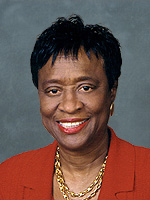Florida 2010 legislative election results
Senate
|
Alabama • Alaska • Arizona • Arkansas • California • Colorado • Connecticut • Delaware • Florida • Georgia • Hawaii • Idaho • Illinois • Indiana • Iowa • Kansas • Kentucky • Maine • Maryland • Massachusetts • Michigan• Minnesota • Missouri • Montana • Nebraska • Nevada • New Hampshire • New Mexico • New York • North Carolina • North Dakota • Ohio • Oklahoma • Oregon • Pennsylvania • Rhode Island • South Carolina • South Dakota • Tennessee • Texas • Utah • Vermont • Washington • West Virginia • Wisconsin • Wyoming |
| Other 2010 Election information |
Florida State Senate Election Results
This page contains macro-level election results and analysis for the Florida State Senate. For results in individual contests see our Florida State Senate elections, 2010 page. The following is a breakdown of the state senate before and after the election:
| Florida State Senate | |||
|---|---|---|---|
| Party | As of November 1, 2010 | After the 2010 Election | |
| Democratic Party | 13 | 12 | |
| Republican Party | 26 | 28 | |
| Vacancy | 1 | - | |
| Total | 40 | 40 | |
What You'll See on This Page
This page displays the following lists of candidates
- Incumbents who ran on November 2
- Incumbents who were defeated
- Challengers who defeated an incumbent
- Newly elected senators
- List of all winners
- Unopposed candidates
- Third party candidates
State Senate Overview:
- There were 10 incumbents who ran in the November 2 general election. No incumbents lost, and thus 10 incumbents were re-elected to the Florida State Senate.
- There will be 13 new senators sworn-in. Of those 13, 3 are Democrats and 10 are Republicans
- Of the 23 seats up for election, 6 were won by Democrats and 17 by Republicans.
- 14 candidates were unopposed, 4 Democrats and 10 Republicans.
- 14 candidates ran as an independent or third party candidate in the general election.
Incumbency Analysis
Of the 1,167 state senate seats up for election in 2010, incumbents ran for 894 (76.6%) of them. Of these 894, 94 lost their re-election bids, 89 Democrats and 5 Republicans. In Florida, 13 incumbent senators did not run for re-election on the November 2 ballot, while 10 incumbents (43.5%) ran for re-election. Of these 10 incumbents, none were defeated.
Incumbents who ran on November 2
The following is a list of all of the incumbents who ran on the November 2 general election ballot:
Incumbents defeated
No incumbents were defeated.
Challengers who beat an incumbent
No challengers defeated an incumbent.
New State Senators and General Election Winners
388 new senators were elected across the country. This includes challengers who defeated incumbents as well as candidates who won open seats. Of these 388, 278 were Republicans and 110 were Democrats. In Florida, 13 new senators will be sworn-in. Of those 13, 3 are Democrats and 10 are Republicans. In the 13 open seat contests, Republicans won 10 and Democrats 3. In total, Florida elected 23 senators, 17 Republicans and 6 Democrats.
Newly elected senators
The following are the newly-elected members of the Florida State Senate:
Democratic
Republican
Open Seat Winners
The following is a list of candidates who won election in seats where no incumbent was running:
Democratic
Republican
Candidates who won election
The following is a list of all candidates elected to the Florida State Senate:
Democratic
Republican
Competitiveness
Across the nation, 1,167 state senate seats were up for election in 2010. 1,143 of those seats were partisan seats (24 seats were up for election in Nebraska's nonpartisan unicameral legislature). In 320 (28.0%) of these state senate contests, there was a major party candidate with no major party opposition. In Florida, 14 candidates (60.9% of seats) faced no major party opposition. Of these 14, 4 were Democrats and 10 were Republicans.
Unopposed candidates in general election
The following candidates did not face major party competition:
Democratic
Republican
Ballot Access
Across the nation, 140 independent or third party candidates ran for state senate. In Florida, 14 (30.4%) of the 46 senate candidates ran as an independent or third party candidate. None won election in the November 2 general election.
Third party candidates
The following is a list of third party and independent candidates who ran in 2010:
House
|
Alabama • Alaska • Arizona • Arkansas • California • Colorado • Connecticut • Delaware • Florida • Georgia • Hawaii • Idaho • Illinois • Indiana • Iowa • Kansas • Kentucky • Maine • Maryland • Massachusetts • Michigan• Minnesota • Missouri • Montana • Nebraska • Nevada • New Hampshire • New Mexico • New York • North Carolina • North Dakota • Ohio • Oklahoma • Oregon • Pennsylvania • Rhode Island • South Carolina • South Dakota • Tennessee • Texas • Utah • Vermont • Washington • West Virginia • Wisconsin • Wyoming |
| Other 2010 Election information |
Florida State House Election Results
This page contains macro-level election results and analysis for the Florida House of Representatives. For results in individual contests, see our Florida House of Representatives elections, 2010. The following is a breakdown of the state house before and after the election:
| Florida House of Representatives | |||
|---|---|---|---|
| Party | As of November 1, 2010 | After the 2010 Election | |
| Democratic Party | 44 | 39 | |
| Republican Party | 76 | 81 | |
| Total | 120 | 120 | |
What You'll See on This Page
This page displays the following lists of candidates
- Incumbents who ran on November 2
- Incumbents who were defeated
- Challengers who defeated an incumbent
- Newly elected senators
- List of all winners
- Unopposed candidates
- Third party candidates
State House Overview:
- There were 85 incumbents who ran in the November 2 general election. Only 5 incumbents lost, and thus 80 incumbents were re-elected to the Florida House of Representatives.
- All 5 incumbents who lost were Democratic incumbents.
- There will be 40 new representatives sworn-in. Of those 40, 8 are Democrats and 32 are Republicans
- Of the 120 seats up for election, 39 were won by Democrats and 81 by Republicans.
- 58 candidates were unopposed, 25 Democrats and 33 Republicans.
- 43 candidates ran as an independent or third party candidate in the general election.
Incumbency Analysis
Of the 4,958 state house seats up for election, incumbents ran in the general election for 4,091 (79.5%) of them. Of these 4,091 incumbents, 413 lost their re-election bids, 403 Democrats and 10 Republicans. In Florida, 85 (70.8%) incumbents ran in the general election. Of these 85, 5 incumbent representatives were defeated. All five were Democrats.
Incumbents who ran on November 2
The following is a list of all of the incumbents who ran on the November 2 general election ballot:
- Clay Ford
- Matt Gaetz
- Brad Drake
- Jimmy Patronis
- Marti Coley
- Alan Williams
- Michelle Rehwinkel Vasilinda
- Leonard Bembry
- Debbie Boyd
- Mia Jones
- Charles McBurney
- Lake Ray
- Ronald Renuart
- Michael Weinstein (Florida representative 2008-2012)
- William Proctor
- Charles Van Zant
- Charles Chestnut IV
- Dwayne Taylor
- Dorothy Hukill
- Ritch Workman
- John Tobia
- Steve Crisafulli
- Chris Dorworth
- Dean Cannon
- Scott Randolph
- Scott Plakon
- Bryan Nelson (Florida)
- Geraldine Thompson
- Eric Eisnaugle
- Stephen Precourt
- H. Marlene O'Toole
- Robert Schenck
- John Legg
- Peter Nehr
- Darren Soto
- Ed Hooper
- Janet Long
- Rick Kriseman
- James Frishe
- Darryl Rouson
- Rachel Burgin
- Janet Cruz
- Betty Reed
- Will Weatherford
- Richard Glorioso
- Seth McKeel
- Kelli Stargel
- John Wood (Florida)
- Ben Albritton
- Doug Holder
- Kenneth Roberson
- Paige Kreegel
- Gary Aubuchon
- Trudi Williams
- Denise Grimsley
- Mike Horner
- Debbie Mayfield
- Adam Fetterman
- William Snyder (Florida)
- Mack Bernard
- Joseph Abruzzo
- Mark Pafford
- Gwyndolen Clarke-Reed
- Perry Thurston
- Hazelle Rogers
- James Waldman
- Martin David Kiar
- Franklin Sands
- Elaine Schwartz
- Evan Jenne
- Matt Hudson
- Eduardo Gonzalez (Florida)
- Oscar Braynon
- Joseph Gibbons
- Richard Steinberg
- Luis Garcia (Florida representative)
- Erik Fresen
- Carlos Lopez-Cantera
- Dwight Bullard
- Ron Saunders
- Janet Adkins
- Keith Fitzgerald
- Bill Heller
- Ari Abraham Porth
- Esteban Bovo Jr.
Incumbents defeated
The following is a list of incumbents defeated on November 2:
| Candidate | Party | District |
|---|---|---|
| Debbie Boyd | ||
| Janet Long | ||
| Bill Heller | ||
| Keith Fitzgerald | ||
| Adam Fetterman |
Challengers who beat an incumbent
The following is a list of challengers who defeated an incumbent on November 2:
| Candidate | Party | District |
|---|---|---|
| Elizabeth Porter | ||
| Larry Ahern | ||
| Jeff Brandes | ||
| Ray Pilon | ||
| Gayle Harrell |
New Representatives and General Election Winners
1,345 new representatives were elected across the country. This includes challengers who defeated incumbents as well as candidates who won open seats. Of these 1,345, 988 were Republicans and 357 were Democrats. In Florida, 40 new representatives will be sworn-in. Of those 40, 8 are Democrats and 32 are Republicans. In the 35 open seat contests, Republicans won 27 and Democrats 8. In total, Florida elected 120 representatives, 81 Republicans and 39 Democrats.
Newly elected representatives
The following are the newly-elected members of the Florida House of Representatives:
Democratic
Republican
- Doug Broxson
- Clay Ingram
- Elizabeth Porter
- Daniel Davis (Florida)
- Keith Perry
- Dennis Baxley
- Larry Metz
- Fred Costello
- Tom Goodson
- Jason Brodeur
- Jimmie Todd Smith
- Richard Corcoran (Florida)
- James Grant (Florida)
- Larry Ahern
- Jeff Brandes
- Dana Young
- Shawn Harrison
- Greg Steube
- Jim Boyd
- Ray Pilon
- Matt Caldwell (Florida)
- Kathleen Passidomo
- Gayle Harrell
- Pat Rooney
- Bill Hager (Florida)
- Jeanette Nuñez
- Jose Felix Diaz
- Carlos Trujillo (Florida)
- Michael Bileca
- Frank Artiles
- George Moraitis
Open Seat Winners
The following is a list of candidates who won election in seats where no incumbent was running:
Democratic
Republican
- Doug Broxson
- Clay Ingram
- Daniel Davis (Florida)
- Keith Perry
- Dennis Baxley
- Larry Metz
- Fred Costello
- Tom Goodson
- Jason Brodeur
- Jimmie Todd Smith
- Richard Corcoran (Florida)
- James Grant (Florida)
- Dana Young
- Shawn Harrison
- Greg Steube
- Jim Boyd
- Matt Caldwell (Florida)
- Kathleen Passidomo
- Pat Rooney
- Bill Hager (Florida)
- George Moraitis
- Jeanette Nuñez
- Jose Felix Diaz
- Carlos Trujillo (Florida)
- Michael Bileca
- Frank Artiles
Candidates who won election
The following is a list of all candidates elected to the Florida House of Representatives:
Democratic
- Alan Williams
- Michelle Rehwinkel Vasilinda
- Leonard Bembry
- Mia Jones
- Reggie Fullwood
- Charles Chestnut IV
- Dwayne Taylor
- Scott Randolph
- Geraldine Thompson
- Darren Soto
- Rick Kriseman
- Darryl Rouson
- Janet Cruz
- Betty Reed
- Steven Perman
- Mack Bernard
- Joseph Abruzzo
- Lori Berman
- Mark Pafford
- Jeff Clemens
- Irving Slosberg
- Gwyndolen Clarke-Reed
- Perry Thurston
- Hazelle Rogers
- James Waldman
- Martin David Kiar
- Franklin Sands
- Elaine Schwartz
- Evan Jenne
- Oscar Braynon
- John Patrick Julien
- Joseph Gibbons
- Richard Steinberg
- Luis Garcia (Florida representative)
- Cynthia Stafford
- Daphne Campbell
- Ana Rivas Logan
- Dwight Bullard
- Ron Saunders
- Ari Abraham Porth
Republican
- Doug Broxson
- Clay Ingram
- Clay Ford
- Matt Gaetz
- Brad Drake
- Jimmy Patronis
- Marti Coley
- Elizabeth Porter
- Daniel Davis (Florida)
- Charles McBurney
- Lake Ray
- Ronald Renuart
- Michael Weinstein (Florida representative 2008-2012)
- William Proctor
- Charles Van Zant
- Keith Perry
- Dennis Baxley
- Larry Metz
- Fred Costello
- Dorothy Hukill
- Tom Goodson
- Ritch Workman
- John Tobia
- Steve Crisafulli
- Jason Brodeur
- Chris Dorworth
- Dean Cannon
- Scott Plakon
- Bryan Nelson (Florida)
- Eric Eisnaugle
- Stephen Precourt
- H. Marlene O'Toole
- Jimmie Todd Smith
- Robert Schenck
- Richard Corcoran (Florida)
- John Legg
- James Grant (Florida)
- Peter Nehr
- Ed Hooper
- Larry Ahern
- Jeff Brandes
- James Frishe
- Rachel Burgin
- Dana Young
- Shawn Harrison
- Will Weatherford
- Richard Glorioso
- Seth McKeel
- Kelli Stargel
- John Wood (Florida)
- Ben Albritton
- Greg Steube
- Jim Boyd
- Ray Pilon
- Doug Holder
- Kenneth Roberson
- Paige Kreegel
- Matt Caldwell (Florida)
- Gary Aubuchon
- Trudi Williams
- Kathleen Passidomo
- Denise Grimsley
- Mike Horner
- Debbie Mayfield
- Gayle Harrell
- William Snyder (Florida)
- Pat Rooney
- Bill Hager (Florida)
- Matt Hudson
- Eduardo Gonzalez (Florida)
- Erik Fresen
- Jeanette Nuñez
- Carlos Lopez-Cantera
- Jose Felix Diaz
- Carlos Trujillo (Florida)
- Michael Bileca
- Frank Artiles
- George Moraitis
- Janet Adkins
- Esteban Bovo Jr.
Competitiveness
Across the nation, 4,958 state house seats were up for election in 2010. In 1,680 (33.9%) of these state house contests, there was a major party candidate with no major party opposition. In Florida, 58 candidates (48.33% of all seats) faced no major party opposition. Of these 58, 25 were Democrats and 33 were Republicans.
Unopposed candidates in general election
The following candidates did not face major party competition:
Democratic
- Charles Chestnut IV
- Darren Soto
- Alan Williams
- Betty Reed
- Cynthia Stafford
- Darryl Rouson
- Daphne Campbell
- Dwayne Taylor
- Elaine Schwartz
- Evan Jenne
- Geraldine Thompson
- Gwyndolen Clarke-Reed
- Hazelle Rogers
- Janet Cruz
- John Patrick Julien
- Joseph Gibbons
- Lori Berman
- Mark Pafford
- Martin David Kiar
- Mia Jones
- Oscar Braynon
- Perry Thurston
- Richard Steinberg
- Steven Perman
- Ari Abraham Porth
Republican
- Ben Albritton
- Brad Drake
- Bryan Nelson (Florida)
- Carlos Trujillo (Florida)
- Charles McBurney
- Charles Van Zant
- Clay Ingram
- Debbie Mayfield
- Denise Grimsley
- Doug Broxson
- Dorothy Hukill
- Eduardo Gonzalez (Florida)
- Gary Aubuchon
- H. Marlene O'Toole
- Janet Adkins
- Jim Boyd
- Jimmie Todd Smith
- John Legg
- John Wood (Florida)
- Kathleen Passidomo
- Lake Ray
- Matt Gaetz
- Michael Weinstein (Florida representative 2008-2012)
- Paige Kreegel
- Richard Glorioso
- Richard Corcoran (Florida)
- Scott Plakon
- Seth McKeel
- Steve Crisafulli
- Tom Goodson
- Trudi Williams
- William Snyder (Florida)
- Esteban Bovo Jr.
Ballot Access
In Florida, 43 (19.11%) of the 225 house candidates ran as independent or third party candidates. None won election in the November 2 general election.
Third party candidates
The following is a list of third party and independent candidates who ran in 2010:
National Partisan Trends
|
Alabama • Alaska • Arizona • Arkansas • California • Colorado • Connecticut • Delaware • Florida • Georgia • Hawaii • Idaho • Illinois • Indiana • Iowa • Kansas • Kentucky • Maine • Maryland • Massachusetts • Michigan• Minnesota • Missouri • Montana • Nebraska • Nevada • New Hampshire • New Mexico • New York • North Carolina • North Dakota • Ohio • Oklahoma • Oregon • Pennsylvania • Rhode Island • South Carolina • South Dakota • Tennessee • Texas • Utah • Vermont • Washington • West Virginia • Wisconsin • Wyoming |
| Other 2010 Election information |
National Partisan Trends
The following tables detail the partisan breakdown of national election results. These results provide context for Republican gains in Florida.
Incumbents who were defeated in the general election
Across the nation, only 15 Republican incumbents were defeated while 492 Democratic incumbents were defeated. In total, 507 (10.4%) of the 4,872 incumbents running in the general election were defeated. The following is a breakdown of incumbent defeats in the 2010 general election:
The following is the breakdown of incumbents who lost.
| Incumbents defeated in 2010 legislative elections | |||
|---|---|---|---|
| Party | Senate | House | Total |
| Democratic | 89 | 403 | 492 |
| Republican | 5 | 10 | 15 |
| TOTALS | 94 | 413 | 507 |
Total new legislators elected
In total, 1,733 (28.3%) new legislators were elected in 2010. Of these 1,733, 1,266 (73.1%) are Republicans and 467 (26.9%) are Democrats.
The following is the breakdown of new legislators.
| New Legislators after the 2010 legislative elections | |||
|---|---|---|---|
| Party | Senate | House | Total |
| Democratic | 110 | 357 | 467 |
| Republican | 278 | 988 | 1,266 |
| TOTALS | 388 | 1,345 | 1,733 |
Winners of Open Seats
Open seats contests made up 1,178 (19.2%) of the 6,125 seats on November 2. Of these 1,178 open seats, Republicans won 729 (61.9%) while Democrats won 449 (38.1%). Going into the election, the number of open seats formerly held by each party was quite similar. Estimates prior to the election suggest that approximately 52% of the open seats were previously held by Republicans and 48% were held by Democrats.
The following is the breakdown of open seat winners.
| Open Seat Winners in 2010 legislative elections | |||
|---|---|---|---|
| Party | Senate | House | Total |
| Democratic | 108 | 341 | 449 |
| Republican | 191 | 538 | 729 |
| TOTALS | 299 | 879 | 1,178 |
Impact on legislative majorities
- See also: Partisan balance of state legislatures
Heading into the November 2 elections, the Democratic Party held a commanding lead in state houses in the 88 legislative chambers that held elections in 2010. 52 of the 88 chambers, or nearly 60% of them, had a Democratic majority, while only 33 of them had a Republican majority. (Two chambers had an exactly equal number of Democrats and Republicans and one is officially nonpartisan.) The following is a partisan breakdown of state legislatures prior to the November 2 election:
| Partisan breakdown before the November 2010 Election | ||||
|---|---|---|---|---|
| Legislative chamber | ||||
| State senates | 23 | 18 | 1 | 1 |
| State houses | 29 | 15 | 1 | - |
| Totals: | 52 | 33 | 2 | 1 |
As a result of the election, Republicans picked up 20 legislative chambers while Democrats lost 20. Republicans won 53 total chambers on November 2, while Democrats won only 32. The following is a partisan breakdown of state legislatures after the November 2 election:
| Partisan breakdown after the November 2010 Election | ||||
|---|---|---|---|---|
| Legislative chamber | ||||
| State senates | 16 | 25 | 1 | 1 |
| State houses | 16 | 28 | 1 | 0 |
| Totals: | 32 | 53 | 2 | 1 |
Another way to examine the data is to gauge how many chambers had gains for the Democratic Party versus the Republican Party. Using this variable, the wide-sweeping Republican victory is further amplified. Democrats bolstered their majorities in only 7 of 88 (7.96%) state chambers. These legislatures are as follows:
| State legislative chambers where Democrats gained seats on November 2 | ||
|---|---|---|
| State | Chamber | Number of seats gained by Democrats |
| California | Assembly | + 2 |
| Delaware | House | + 2 |
| Hawaii | Senate | + 1 |
| Maryland | Senate | + 2 |
| Massachusetts | Senate | + 1 |
| Missouri | Senate | + 1 |
| West Virginia | Senate | + 1 |
In 7 chambers, the GOP kept their current number of seats. In one chamber, the California State Assembly, both major parties gained seats by filling 2 vacancies and defeating an incumbent independent. Overall, the Republican Party picked up legislative seats in 75 (85.2%) of the 88 legislative chambers that held elections on November 2.
Impact on State Politics
Along with the GOP capture of the U.S. House of Representatives, state Republicans gained trifectas (control of the governorship, house, and senate) in 12 states. The following is a breakdown of trifectas across the nation, before and after the 2010 election:
| Trifectas before and after the 2010 Election | ||||||
|---|---|---|---|---|---|---|
| Party | Before election | U.S. House seats | After election | U.S. House seats | Gain/loss states | Gain/loss congressional seats |
| 16 | 131 | 11 | 115 | -5 | -16 | |
| 8 | 66 | 20 | 198 | +12 | +132 | |
Before the election, 131 U.S House seats were in states with Democratic trifectas, while 66 districts were in states with Republican trifectas. After the election, Republicans trifectas control redistricting for 198 U.S. House seats while Democrats control only 115. Additionally, California, the strongest Democratic trifecta with 53 U.S. House representatives, passed propositions that take redistricting power away from state government.







